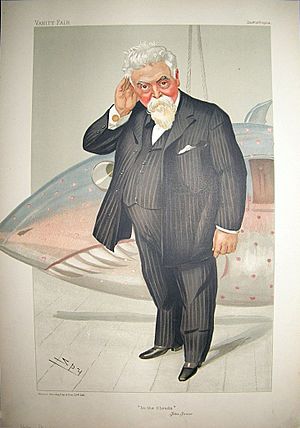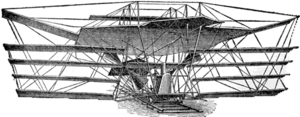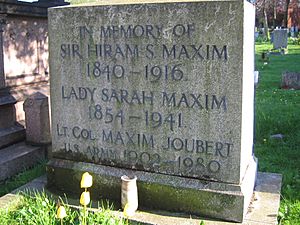Hiram Maxim facts for kids
Quick facts for kids
Hiram Stevens Maxim
|
|
|---|---|
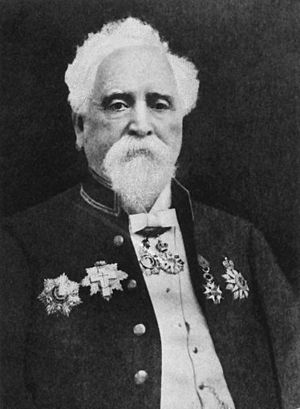
Maxim c.1916
|
|
| Born | 5 February 1840 |
| Died | 24 November 1916 (aged 76) |
| Resting place | West Norwood Cemetery |
| Occupation | Inventor |
| Known for | Inventor of Maxim gun Claimed inventor of lightbulb |
| Spouse(s) | Jane Budden (1867–1881?) Sarah Haynes (1881–1916, his death) |
| Children | Hiram Percy Maxim Florence Maxim Cutter Adelaide Maxim Joubert |
| Relatives | Hudson Maxim (brother) |
Sir Hiram Stevens Maxim (born February 5, 1840 – died November 24, 1916) was an amazing American-British inventor. He is most famous for creating the first automatic machine gun, known as the Maxim gun. Maxim also held many patents for other inventions. These included things like hair-curling irons, a mousetrap, and steam pumps. He even claimed to have invented the lightbulb.
Maxim also tried to invent powered flight machines. His large aircraft designs never flew successfully. To help pay for his research, he designed a popular amusement ride. It was called the "Captive Flying Machine." This ride also helped get people excited about the idea of flying.
Maxim moved from the United States to the United Kingdom when he was 41. He became a naturalised British citizen in 1899. In 1901, he received a knighthood.
Contents
Early Life and Work
Hiram Maxim was born in Sangerville, Maine, on February 5, 1840. When he was 14, he became an apprentice coach builder. This means he learned how to build horse-drawn carriages. Ten years later, he started working at his uncle's machine shop in Fitchburg, Massachusetts. He also worked as an instrument-maker and a draughtsman (someone who draws technical plans). Hiram said he was a Protestant.
Maxim's Many Inventions
Maxim often suffered from bronchitis, a lung condition. Because of this, he invented and sold a small menthol inhaler for pockets. He also made a larger "Pipe of Peace," which was a steam inhaler. He claimed it could help with asthma, ear ringing (tinnitus), hay fever, and a stuffy nose (catarrh). Some people criticized him for inventing things that seemed like "quackery." He replied that it was seen as good to invent a "killing machine," but a "disgrace" to invent something to stop human suffering.
He also invented many other things. These included a curling iron, a device to remove magnetism from watches, and machines to prevent ships from rocking. He also made machines for eyelets and rivets, aircraft artillery, and even coffee substitutes.
Once, a large furniture factory kept burning down. Maxim was asked for ideas to prevent this. He then invented the first automatic fire sprinkler system. This system would spray water on areas that were on fire. It would also tell the fire station about the fire. Maxim could not sell his idea at first. But after his patent expired, the idea was widely used.
In the late 1870s, Maxim installed the first electric lights in a New York City building. This was the Equitable Life Building at 120 Broadway. He had many long arguments with Thomas Edison about who invented the lightbulb. Maxim believed Edison got credit because he understood patenting laws better.
The Maxim Gun
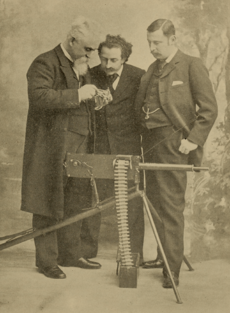
Maxim once said that in 1882, a friend told him: "If you want to make a lot of money, invent something that will help these Europeans kill each other more easily!"
When Maxim was a child, a rifle's powerful kick (recoil) knocked him over. This experience gave him an idea: what if that recoil force could be used to make a gun fire automatically? Between 1883 and 1885, Maxim patented different ways to make a gun automatic. After moving to England, he developed his machine gun design. It used the energy from a shot to prepare the gun for the next shot. He even warned his neighbors in the local newspaper that he would be testing the gun in his garden. He told them to keep their windows open to avoid broken glass!
Maxim started a weapons company with money from Edward Vickers. They made his machine gun in Crayford, Kent. This company later joined with another one called Nordenfelt. Eventually, it became part of 'Vickers, Son & Maxim'. They improved the Maxim gun design, creating the Vickers machine gun. This gun became the main British machine gun for many years. The Maxim gun was sold all over the world. Different versions of it were used by both sides during World War I.
In his later years, Maxim became very deaf. His hearing was damaged from years of being around the loud noise of his guns.
Flying Machines
Maxim's father had an idea for a helicopter with two spinning blades. But he could not find an engine powerful enough to build it. Hiram first drew plans for a helicopter in 1872. But when he built his first "flying machine," he decided to use wings instead. He did many tests on wing shapes and propeller designs. He used a wind tunnel and a special spinning test rig.
In 1889, he started building a huge machine. It was about 40 feet (12 meters) long and had a 110-foot (33.5-meter) wingspan. It weighed 3.5 tons! It was powered by two lightweight steam engines. These engines drove two large 17-foot (5-meter) propellers.
This machine was built as a test rig. It ran on an 1,800-foot (550-meter) long rail track at his home in Bexley. At first, he used heavy iron wheels to stop it from lifting off. But he realized this wasn't enough. So, he added four smaller wheels on outriggers. These were held down by wooden rails outside the main track. In tests in 1894, the machine did lift off the main track. The outriggers stopped it from flying away. But it pulled up the track! Maxim stopped working on this flying machine after that. He realized that a successful flying machine needed lighter, more powerful engines, like a petrol engine.
Captive Flying Machines
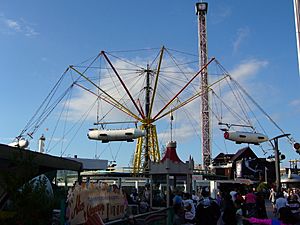
To help pay for his flight research and to get people interested in flying, Maxim designed an amusement ride. He built it for an exhibition in London in 1904. The ride was based on a test machine he used for his research. It had a large spinning frame with cars hanging from it. As the machine spun, the cars would swing out through the air. This made riders feel like they were flying.
Maxim wanted riders to control their flight using small wings. But this was not allowed because it was unsafe. Maxim quickly lost interest in the ride after that. He called it "Simply a glorified merry-go-round." However, his company built several more of these rides. They were placed at The Crystal Palace and at seaside resorts like Blackpool. All of them opened in 1904.
Even though Maxim was not happy with the project, the rides were very popular. The ride at Blackpool still works today! It is part of the Blackpool Pleasure Beach amusement park. It is one of the oldest operating amusement rides in Europe. The "Sir Hiram Maxim's Captive Flying Machines" ride in Blackpool is almost exactly the same as Maxim's original design.
In 2001, Disney California Adventure Park opened a similar ride called the Golden Zephyr. Disney engineers visited the Blackpool ride to help them design their own.
Grahame-White, Blériot, and Maxim Company
In 1911, Maxim became the head of a new company. It was called the Grahame-White, Blériot, and Maxim Company. He started it with two famous aviators and a lot of money. He hoped to build military aircraft that could scout or drop bombs. But his health was failing, and he had money problems with his other businesses. So, he could not fully develop this company before he died.
His Views on the World
Maxim was an atheist (someone who does not believe in God). He put together a book called Li Hung Chang's Scrapbook. This book was for a Chinese leader named Li Hung Chang. Maxim wanted to explain why Western people who could build amazing machines also had religions that seemed strange to the Chinese.
Maxim did not think highly of European missionaries in China. He said his book aimed to show that "we were not all fools." His book had about 400 pages and many pictures. It shared his thoughts on Christianity, miracles, faith, and the Bible's influence. He ended his book by talking about why missionary efforts in China were not working.
Honors and Knighthood
Maxim received many honors. He was a Chevalier of the Legion of Honour (a French award). He was also a Civil, Mechanical, and Electrical Engineer. He was a member of the London Chamber of Commerce, the Royal Institution, and the British Association for the Advancement of Science. He was also a Fellow of the Royal Society of Arts.
In 1881, Maxim came to Britain to help with the London offices of an American electric lighting company. He visited the United States less and less often. On September 16, 1899, he became a British citizen. The next year, Queen Victoria decided to make him a knight. Queen Victoria died in January 1901. So, his "friend and new king, Edward VII" officially made him a knight on February 9, 1901.
Death
Hiram Maxim died at his home in Streatham, London, on November 24, 1916. He was 76 years old. He is buried in West Norwood Cemetery in south London. His wife and grandson are buried there with him.
Family Life
Hiram's brother, Hudson Maxim, was also an inventor. He specialized in explosives. They worked together for a while. But later, they had a disagreement about a patent for smokeless powder. Hiram claimed the patent was issued under 'H. Maxim', which allowed Hudson to claim it as his own. Hudson sold weapons in the U.S., while Hiram worked mostly in Europe. Hudson's success made Hiram jealous. This caused a lasting disagreement between the brothers.
Hiram Maxim married his first wife, Jane Budden, on May 11, 1867, in Boston, Massachusetts. They had three children: Hiram Percy Maxim, Florence Maxim, and Adelaide Maxim.
His son, Hiram Percy Maxim, also became an engineer and weapons designer. But he is perhaps best known for his early amateur radio experiments. He also founded the American Radio Relay League. Hiram Percy invented the "Maxim Silencer" to reduce gun noise. Sadly, it was invented too late to save his father's hearing. Hiram Percy later wrote a book about his father called A Genius in the Family. It has about 60 short, fun stories about his experiences with his father when he was a child. These stories give a look into Hiram Maxim's personal and family life. A movie called So Goes My Love was made in 1946, based on these stories.
Hiram Maxim married his secretary, Sarah Haynes, in 1881. It is not clear if he was legally divorced from his first wife at this time.
Books by Hiram Maxim
- Artificial and Natural Flight (1908, 1909)
- Li Hung Chang's Scrapbook
- A New System of Preventing Collisions at Sea (2009)
- My Life (1915)
- Monte Carlo facts and fallacies (1904)
Patents
- U.S. Patent 208,252 – Electric lamp
- U.S. Patent 230,310 – Electric lamp
- U.S. Patent 230,953 – Electric lamps
- U.S. Patent 230,954 – Process for removing air from globes of electric lamps
- U.S. Patent 230,309 – Electric lamp
- U.S. Patent 234,835 – Electrical lamp
- U.S. Patent 237,198 – Process of manufacturing carbon conductors
- U.S. Patent 244,277 – Electric Lamp
- U.S. Patent 247,083 – Process of Manufacturing Carbons
- U.S. Patent 247,084 – Incandescent Electric Lamp
- U.S. Patent 247,085 – Process of Manufacturing Carbon Conductors
- U.S. Patent 247,380 – Electric Lamp
- U.S. Patent 255,308 – Electrical meter
- U.S. Patent 277,846 – Process of Manufacturing Carbons for Incandescent Lamps
- U.S. Patent 283,629 – Electric Lamp
- U.S. Patent 321,513 – Machine Gun
- U.S. Patent 405,239 – Apparatus for the Manufacture of Filaments for Incandescent Lamps
- U.S. Patent 405,170 – Manufacture of Filaments for Electric Lamps
- U.S. Patent 430,212 – Manufacture of explosive
- U.S. Patent 618,703 – Apparatus for Manufacturing Filaments for Electric Lamps
- U.S. Patent 618,704 – Method of Manufacturing Filaments for Electric Lamps
- Maxim, Hiram Stevens & Louis Silverman, "Improvements in the Firing Mechanism of Automatic Guns", GB 189700207, issued 30 October 1897
- Maxim, Hiram Stevens, "Improvements in Automatic Guns", GB 189607468, issued 27 February 1897, gas action for machine guns
- Maxim, Hiram Stevens, "Improvements in Automatic Machine Guns", GB 189607045, issued 13 March 1897, breech mechanism of machine gun
See also
 In Spanish: Hiram Stevens Maxim para niños
In Spanish: Hiram Stevens Maxim para niños
- William Cantelo, an early machine gun inventor who disappeared in the 1880s. His family believed he might have become Hiram Maxim.


